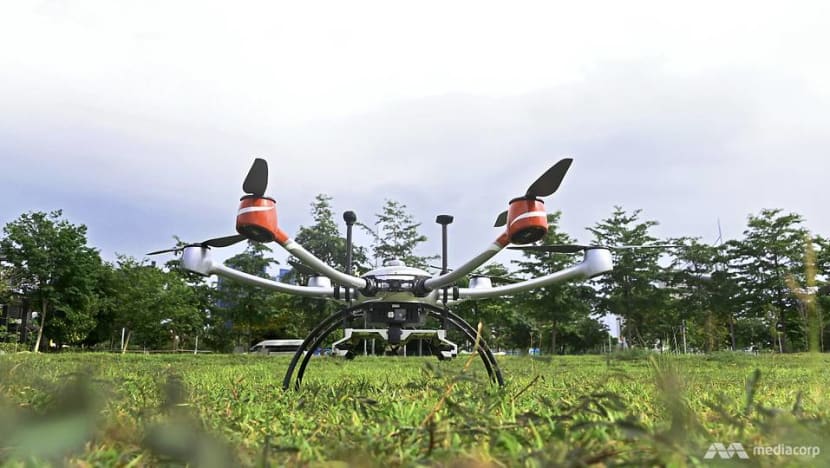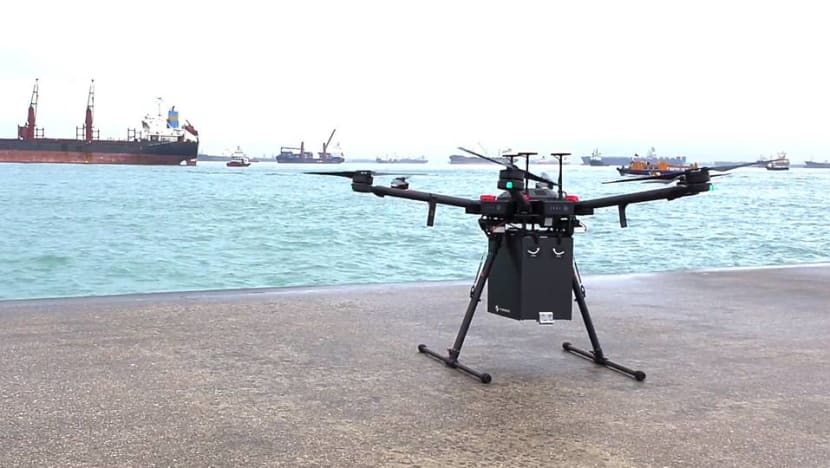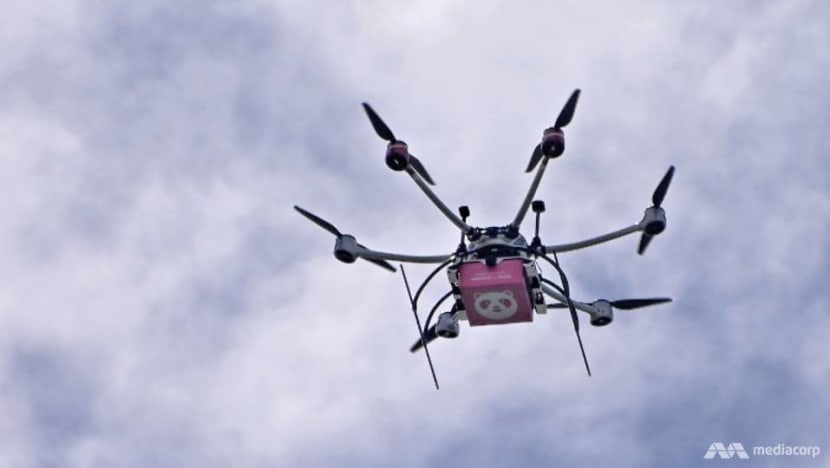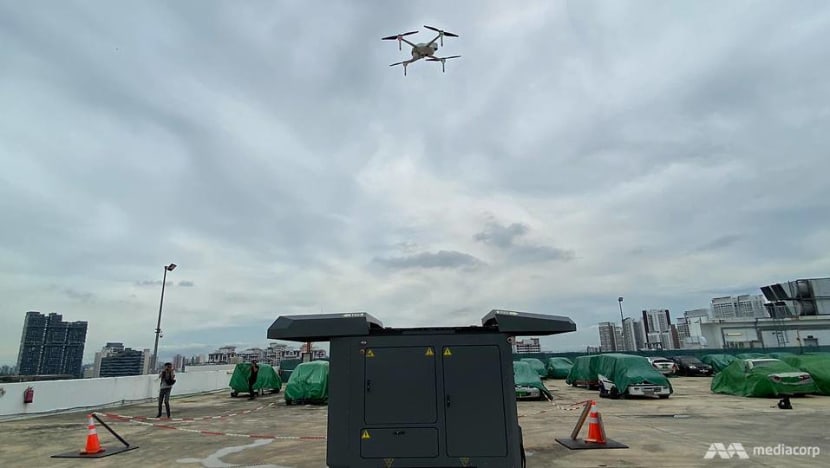Singapore's drone sector takes off with more potential for range of uses: Industry players

ST Engineering's DrN-15L drone was used to deliver five packets of ayam penyet from the Marina South Pier to a vessel located 3km offshore. (Photo: Hanidah Amin)
SINGAPORE: The drone industry in Singapore is taking off, with more companies turning to unmanned aerial vehicles for purposes like infrastructure inspection and deliveries.
In April, local start-up F-Drones became the first company to conduct drone deliveries here. It signed a one-year deal with shipping giant Eastern Pacific Shipping that kicked off with a delivery from Marina South Pier to a vessel anchored 2.7km offshore.
Another start-up, Aerolion Technologies, was granted funding by government agencies to develop a building cleaning drone. It also recently won a contact with water agency PUB to deploy drones for canal inspections.
And last Thursday (Aug 13), foodpanda announced that it is partnering ST Engineering to test the use of drones for food deliveries, as it flew five packets of ayam penyet to a ship 3km offshore.
READ: Foodpanda collaborates with ST Engineering on drone food delivery trials

The Singapore Unmanned Aircraft System (SG UAS) Community, which represents the interests of the nascent industry, has seen an increase in the number of member organisations from 22 last year to 39 currently.
This is expected to grow further, said Mr Sia Kheng Yok, chief executive of the Association of Aerospace Industries (Singapore), which the SG UAS Community is part of.
Members include Singapore-based UAS service providers, manufacturers, suppliers, institutes of higher learning and end-users.
The community plays a role in supporting market development and access, as well as the development of standards and policy advocacy. Its facilities include an indoor testbed site at JTC’s Seletar Aerospace Park for the purpose of demonstrating and testing drones.

DRONES AND THE PANDEMIC
The use of drones allows for many tasks to be carried out more efficiently, said Mr Sia, adding that the COVID-19 pandemic has spurred greater interest in unmanned aerial aircraft.
“(They) are able to operate remotely at height, in confined spaces and over distances, without placing human operators in a position of risk. Integrated with sensors and image analysis software, they can augment the work of humans in areas,” Mr Sia said.
“During COVID-19, the ability of UA to be deployed in remote operations has seen a surge of interest - for monitoring of crowds, broadcasting of warnings, measuring temperatures, remote deliveries of PPE and lab tests,” he noted.
“UAs have the important advantage in that they can minimise face-to-face contact and the need for human interaction while carrying out tasks, enabling businesses and public agencies to perform critical services while reducing risk of exposure to the virus.”
READ: Singapore to launch maritime drone zone, mulls mandatory registration of drones
In April, the National Parks Board said it had deployed 30 drones to monitor crowds in selected parks and nature areas to ensure that visitors keep to safe distancing measures.
The Singapore Police Force also announced in May the use of drones to patrol industrial estates during the country’s “circuit breaker” period.

That same month, Singapore-based Drone Solutions Services started a programme called “Drones in the age of COVID-19” to encourage the use of drones for purposes such as monitoring during the pandemic.
The company’s products include drones with cameras and loudspeakers as well as tethered drone stations, which connect drones to a portable continuous power source.
This would allow drones to remain airborne for hours at a time to monitor crowds, instead of being restricted to a battery life of between 30 and 40 minutes, said Drone Solutions executive director Gianluca Salone.
READ: The Big Read: Rise of the drones - capable of good and evil, they pose a regulatory dilemma
Another area of potential is the use of drones in unmanned search and rescue missions, said Mr Salone, who has two decades of experience in humanitarian work with organisations such as the United Nations.
During natural disasters, for instance, drones can be equipped with devices that can locate people using their mobile phones even when there is no coverage, he said.
Singapore could act as a hub from which such drone operations could be deployed to around the region, he suggested.
Mr Salone, who is a water and environmental engineer by training, said he is also in discussions with agencies on underwater drones, which can be used to conduct maintenance work at places such as the Marina Barrage, as well as removing trash and oil spills from water.

CHALLENGES AND LIMITATIONS
Mr Sia noted, however, that there are still technological limits on the performance of drones, including constraints on the payload weight as well as their access to bandwidth and communications network coverage.
“A second constraint is the importance of ensuring safe use of airspace by UA and manned aircraft,” he said, adding that sophisticated unmanned aircraft traffic management (UTM) systems are still under development.
In recent years, drones have disrupted airport operations in various cities around the world.
In 2018, drones disrupted flights at London's Gatwick Airport for three days, affecting about 140,000 passengers and 1,000 flights.
Last year, unauthorised drone operations in the vicinity of Singapore’s Changi Airport, affected 38 flights and disrupted operations on one runway for 10 hours.
READ: Eagles, lasers and nets: Options for dealing with rogue drone flights
Having a UTM system in place could help enforcement agencies pinpoint the exact location of rogue drones, rather than having to locate them visually, said Nova Systems Asia managing director Ryan Lee.
In 2018, Singapore’s Ministry of Transport and the Civil Aviation Authority of Singapore awarded a consortium led by Nova Systems a project to undertake the research and development of UTM technologies here.

Its researchers have spent two years studying and developing measures to be able to customise and safely scale up multiple UAS operations in Singapore’s densely populated and urban environment.
Last December, it said it successfully completed the second stage of flight trials for UTM in Singapore, including a study of the telecommunication network and the operational suitability of 4G and 5G networks.
While a UTM system would manage the flight plans of drones, just as similar conventional air traffic control manages that of manned aircraft, it is in fact more complex, noted Mr Lee.
This is because the system would not only have to manage multiple drones on different routes, but also account for obstacles such as buildings, trees and even birds, he said.
READ: Drone disruptions at airports: How dangerous are they to aircraft?
The use of such UTM systems could even eventually see drones flying beyond Singapore’s shores, said Mr Sia.
“Such UTM, user-IDs or tracking devices on UA, should be harmonised internationally to standardise the technology and one day even facilitate cross border flights,” he added.















